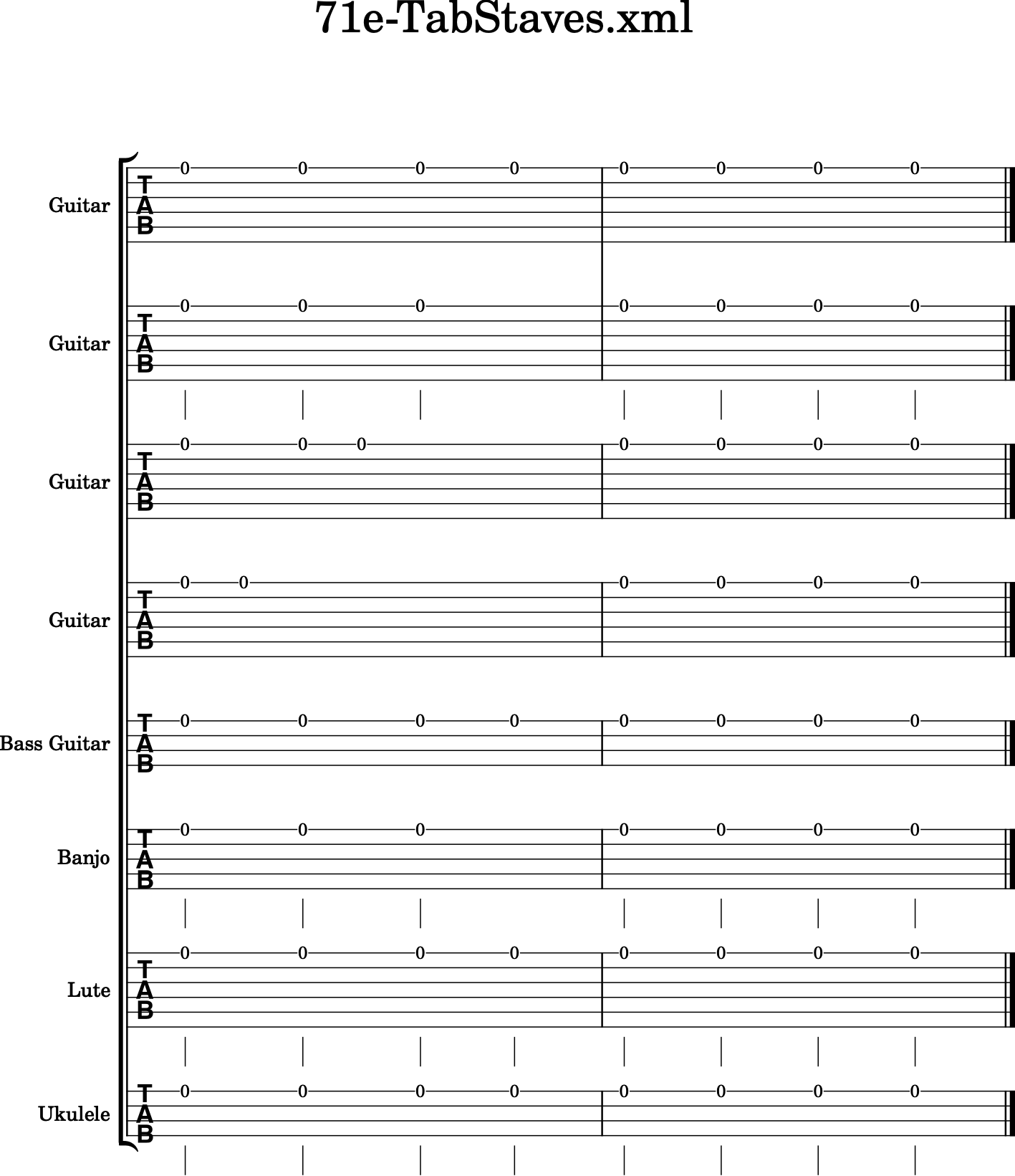Unofficial MusicXML Test Suite¶
(based on Lilypond Test Suite)
from music21 import *
print(musicxml.lilypondTestSuite.__doc__)
The Lilypond MusicXML Test Suite comes from
https://github.com/cuthbertLab/musicxmlTestSuite
and is a fork of
http://lilypond.org/doc/v2.18/input/regression/musicxml/collated-files
The test suite is licensed under the MIT license
(https://opensource.org/license/mit/)
and copyrighted by the Lilypond project.
import os
import re
import pathlib
allF = musicxml.lilypondTestSuite.allFiles()
untested = [f.name for f in sorted(allF)]
scores = {}
musicxmlOut = {}
def s(i):
if isinstance(i, int):
longFp = allF[i]
else:
for longFp in allF:
shortFp = longFp.name
if i in shortFp:
break
else:
raise FileNotFoundError("Cannot find: " + str(i))
shortFp = longFp.name
if shortFp in untested:
untested.remove(shortFp)
sc = converter.parse(longFp, forceSource=True)
scores[i] = sc
fp = pathlib.Path(sc.metadata.filePath).name
print(fp + '\n')
desc = sc.metadata.description
desc = re.sub(r'\s+', ' ', desc)
print(desc)
fpOut = sc.write('musicxml')
with open(fpOut, 'r') as musicxmlOutFile:
allOut = musicxmlOutFile.read()
musicxmlOut[i] = allOut
return sc.show()
01 … Pitches¶
s('01a')
01a-Pitches-Pitches.xml
All pitches from G to c'''' in ascending steps; First without accidentals, then with a sharp and then with a flat accidental, then with explicit natural accidentals. Double alterations and cautionary accidentals are tested at the end.

s('01b')
01b-Pitches-Intervals.xml
All pitch intervals in ascending jump size.

s('01c')
01c-Pitches-NoVoiceElement.xml
The <voice> element of notes is optional in MusicXML (although Dolet always writes it out). Here, there is one note with lyrics, but without a voice assigned. It should still be correctly converted.

s('01d')
01d-Pitches-Microtones.xml
Some microtones: c flat-and-a-half, d half-flat, e half-sharp, f sharp-and-a half. Once in the lower and once in the upper region of the staff.

s('01e') # no visual distinctions are necessary
01e-Pitches-EditorialCautionaryAccidentals.xml
Accidentals can be cautionary or editorial. Each measure has a normal accidental, an editorial, a cautionary and an editorial and cautionary accidental. These do not need to be graphically distinguished in later XML Versions.

s('01ea') # only parentheses supported by m21 or MuseScore/Finale
01ea-Pitches-Parenthesis-Changed-Accidentals.xml
Accidentals have styling attributes. The first measure's accidentals should be normal, parenthesized, bracketed, and praenthesized-and-bracketed. Measure 2 has the sharp shifted to the right of the note, while Measure 3 has the sharp shifted above the note. Measure 4 should have a red accidental. Measure 5 and 6 should have a large accidental, created using the size and font-size attributes respectively.

s('01f') # no visual distinctions are necessary
01f-Pitches-EditorialMicrotoneAccidentals.xml
Microtone accidentals can be cautionary or editorial. Each measure has a normal accidental, an editorial, a cautionary and an editorial and cautionary accidental. No visual distinctions are necessary

02 … Rests¶
s('02a')
02a-Rests-Durations.xml
All different rest lengths: A two-bar multi-measure rest, a whole rest, a half, etc. until a 128th-rest; Then the same with dotted durations.

s('02b')
02b-Rests-PitchedRests.xml
Rests can have explicit pitches, where they are displayed. The first rest uses no explicit position and should use the default position, all others are explicitly positioned somewhere else.

s('02c')
02c-Rests-MultiMeasureRests.xml
Four multi-measure rests: 3 measures, 15 measures, 1 measure, and 12 measures.

s('02d')
02d-Rests-Multimeasure-TimeSignatures.xml
Multi-Measure rests should always be converted into durations that are a multiple of the time signature.

s('02e')
02e-Rests-NoType.xml
In some cases, a rest might not have its type attribute set (this happens, for example, with voices in Finale, where you don't manually insert a rest).

03 … Rhythm¶
s('03aa')
03aa-Rhythm-Durations.xml
All common note durations, from brevis, whole until 64th; First with their plain values, then dotted and finally doubly-dotted (to 32nd).

s('03ab')
03ab-Rhythm-Durations.xml
Extreme note durations (pre 3.0): long and 128th; First with their plain values, then dotted and finally doubly-dotted.

s('03b') # music21 creates a Rest w/ hideObjectOnPrint in this case.
03b-Rhythm-Backup.xml
Two voices with a backup, that does not jump to the beginning for the measure for voice 2, but somewhere in the middle. Voice 2 thus won't have any notes or rests for the first beat of the measures.

s('03c')
03c-Rhythm-DivisionChange.xml
Although uncommon, the divisions of a quarter note can change somewhere in the middle of a MusicXML file. Here, the first half measure uses a division of 1, which then changes to 8 in the middle of the first measure and to 38 in the middle of the second measure.

s('03d') # failing on not recognizing a way around 5/16, 9/8
03d-Rhythm-DottedDurations-Factors.xml
Several durations can be written with dots. For multimeasure rests, we can also have durations that cannot be expressed with dotted notes (5/16 and 9/8).

scores['03d'].show('text') # import is fine.
{0.0} <music21.metadata.Metadata object at 0x108178290>
{0.0} <music21.stream.Part MusicXML Part>
{0.0} <music21.instrument.Instrument 'P1: MusicXML Part: '>
{0.0} <music21.stream.Measure 1 offset=0.0>
{0.0} <music21.meter.TimeSignature 1/8>
{0.0} <music21.note.Note C>
{0.0} <music21.spanner.MultiMeasureRest 1 measure>
{0.0} <music21.spanner.MultiMeasureRest 1 measure>
{0.0} <music21.spanner.MultiMeasureRest 1 measure>
{0.0} <music21.spanner.MultiMeasureRest 1 measure>
{0.0} <music21.spanner.MultiMeasureRest 1 measure>
{0.0} <music21.spanner.MultiMeasureRest 1 measure>
{0.0} <music21.spanner.MultiMeasureRest 1 measure>
{0.0} <music21.spanner.MultiMeasureRest 1 measure>
{0.5} <music21.stream.Measure 2 offset=0.5>
{0.0} <music21.note.Rest eighth>
{1.0} <music21.stream.Measure 3 offset=1.0>
{0.0} <music21.meter.TimeSignature 2/8>
{0.0} <music21.note.Note C>
{2.0} <music21.stream.Measure 4 offset=2.0>
{0.0} <music21.note.Rest quarter>
{3.0} <music21.stream.Measure 5 offset=3.0>
{0.0} <music21.meter.TimeSignature 3/4>
{0.0} <music21.note.Note C>
{6.0} <music21.stream.Measure 6 offset=6.0>
{0.0} <music21.note.Rest dotted-half>
{9.0} <music21.stream.Measure 7 offset=9.0>
{0.0} <music21.meter.TimeSignature 4/4>
{0.0} <music21.note.Note C>
{13.0} <music21.stream.Measure 8 offset=13.0>
{0.0} <music21.note.Rest whole>
{17.0} <music21.stream.Measure 9 offset=17.0>
{0.0} <music21.meter.TimeSignature 5/16>
{0.0} <music21.note.Note C>
{1.0} <music21.note.Note C>
{18.25} <music21.stream.Measure 10 offset=18.25>
{0.0} <music21.note.Rest 1.25ql>
{19.5} <music21.stream.Measure 11 offset=19.5>
{0.0} <music21.meter.TimeSignature 7/8>
{0.0} <music21.note.Note C>
{23.0} <music21.stream.Measure 12 offset=23.0>
{0.0} <music21.note.Rest 3.5ql>
{26.5} <music21.stream.Measure 13 offset=26.5>
{0.0} <music21.meter.TimeSignature 9/8>
{0.0} <music21.note.Note C>
{4.0} <music21.note.Note C>
{31.0} <music21.stream.Measure 14 offset=31.0>
{0.0} <music21.note.Rest 4.5ql>
{35.5} <music21.stream.Measure 15 offset=35.5>
{0.0} <music21.meter.TimeSignature 31/8>
{0.0} <music21.note.Note C>
{51.0} <music21.stream.Measure 16 offset=51.0>
{0.0} <music21.note.Rest 15.5ql>
{66.5} <music21.stream.Measure 17 offset=66.5>
{0.0} <music21.meter.TimeSignature 2/2>
{0.0} <music21.note.Note C>
11 … Time signatures¶
s('11a')
11a-TimeSignatures.xml
Various time signatures: 2/2 (alla breve), 4/4 (C), 2/2, 3/2, 2/4, 3/4, 4/4, 5/4, 3/8, 6/8, 12/8

s('11b')
11b-TimeSignatures-NoTime.xml
A score without a time signature (but with a key and clefs)

s('11c')
11c-TimeSignatures-CompoundSimple.xml
Compound time signatures with same denominator: (3+2)/8 and (5+3+1)/4.

s('11d') # blocking: MuseScore. Finale OK
11d-TimeSignatures-CompoundMultiple.xml
Compound time signatures with separate fractions displayed: 3/8+2/8+3/4 and 5/2+1/8.

for m in scores['11d'].recurse().getElementsByClass('TimeSignature'):
print(m, m.displaySequence.flat)
<music21.meter.TimeSignature 3/8+2/8+3/4> {3/8+2/8+3/4}
<music21.meter.TimeSignature 5/2+1/8> {5/2+1/8}
s('11e') # blocking: MuseScore, Finale OK
11e-TimeSignatures-CompoundMixed.xml
Compound time signatures of mixed type: (3+2)/8+3/4.

s('11f') # acceptable though different meaning from Lilypond
11f-TimeSignatures-SymbolMeaning.xml
A time signature of 3/8 with the symbol="cut" attribute and two symbol="single-number" attributes with compound time signatures. Shall the symbol be ignored in this case?

s('11g') # block: MuseScore
11g-TimeSignatures-SingleNumber.xml
Time signature displayed as a single number.

ts = scores['11g'].recurse().getElementsByClass('TimeSignature')[0]
ts.symbol
'single-number'
s('11h')
11h-TimeSignatures-SenzaMisura.xml
Senza-misura time signature

sc = scores['11h']
sc.recurse().getElementsByClass('SenzaMisuraTimeSignature')[0]
<music21.meter.SenzaMisuraTimeSignature>
12 … Clefs¶
s('12aa')
12aa-Clefs_Pitch_Traditional.xml
Four traditional clefs: G-treble, C-alto, C-tenor, F-bass

s('12ab')
12ab-Clefs-Percussion-NonTrad.xml
Clefs with octave shifts, clefs on staff lines other than default, and percussion. Order: Percussion, treble 8vb, bass 8vb, F3, G1, C5, C2, C1, treble 8va, bass 8va,

s('12ac') # block: MuseScore
12ac-Clefs-TAB-Switch.xml
none clef, TAB clef, Treble

s('12ad') # block: MuseScore on treble 15vb, treble 22va, bass 22vb.
12ad-Clefs-Extreme-Octave.xml
Clefs with abs(octave shifts) > 1 Order: treble 15vb (C2), bass 15vb (C2), treble 15va (C6), bass 15va (C6), treble 22va (C7), bass 22vb (C1). Should all display as middle C if clef octavation is ignored

s('12b')
12b-Clefs-NoKeyOrClef.xml
A score without any key or clef defined. The default (4/4 in treble clef) should be used.

13 … Key signatures¶
s('13a')
13a-KeySignatures.xml
Various standard key signatures: from 7 flats to 7 sharps (each one first one measure in major, then one measure in minor)

s('13aa') # blocked: MuseScore and Finale (on flats; sharps import fine)
13aa-KeySignatures-Extreme.xml
Various extreme key signatures: from 11 flats to 7 flats and 7 sharps to 11 sharps (all marked as major)

print([ks.sharps for ks in scores['13aa'].recurse().getElementsByClass('KeySignature')])
[-11, -10, -9, -8, -7, 7, 8, 9, 10, 11]
s('13ab') # no music21 support; blocked MuseScore
13ab-KeySignatures-Cancel.xml
Tests of key signature cancelation, at default location, at right, and before-barline, then cancelling a key signature that does not exist...

s('13ac') # no music21 support; blocked MuseScore + Finale
13ac-KeySignatures-Octaves.xml
Three tests of key signatures at octaves other than defaults. The third example uses the cancel element to cancel previous key signature octaves

s('13b')
13b-KeySignatures-ChurchModes.xml
All different modes: major, minor, ionian, dorian, phrygian, lydian, mixolydian, aeolian, and locrian; All modes are given with 2 sharps.

print([k.mode for k in scores['13b'].recurse().getElementsByClass('Key')])
['major', 'minor', 'ionian', 'dorian', 'phrygian', 'lydian', 'mixolydian', 'aeolian', 'locrian']
s('13c') # no octave support on musescore or finale
13c-KeySignatures-NonTraditional.xml
Non-traditional key signatures, where each alteration is separately given. Here we have (f sharp, a flat, b flat) and (c flatflat, g sharp sharp, d flat, b sharp, f natural), where in the second case an explicit octave is given for each alteration.

s('13d') # great musescore support except octaves. no Finale support;
13d-KeySignatures-Microtones.xml
Non-traditional key signatures with microtone alterations: (g flat-and-a-half, a flat, b half-flat, c natural, d half-sharp, e sharp, f sharp-and-a-half).

s('13e')
13e-KeySignatures-MidMeasure-Change.xml
Mid-Measure Key-Change: 2 sharps, 2 flats, 0 sharps/flats, 7 sharps, no mode.

14 … Staff attributes¶
# failing on mid-measure staff-details change.
# Incorrect interpretation of lines is MuseScore; finale incorrect also
s('14a')
14a-StaffDetails-LineChanges.xml
The number of staff lines can be modified by using the staff-lines child of the staff-details attribute. This can happen globally (the first staff has one line globally) or during the part at the beginning of a measure and even inside a measure (the second part has 5 lines initially, 4 at the beginning of the second measure, and 3 starting in the middle of the third measure).

21 … Chorded notes¶
s('21a')
21a-Chord-Basic.xml
One simple chord consisting of two notes.

s('21b')
21b-Chords-TwoNotes.xml
Some subsequent (identical) two-note chords.

s('21c')
21c-Chords-ThreeNotesDuration.xml
Some three-note chords, with various durations.

s('21d')
21d-Chords-SchubertStabatMater.xml
Chords in the second measure, after several ornaments in the first measure and a p at the beginning of the second measure.

s('21e')
21e-Chords-PickupMeasures.xml
Check for proper chord detection after a pickup measure (i.e. the first beat of the measure is not aligned with multiples of the time signature)!

s('21f') # failing -- finale interprets chord correctly, but not the p; musescore, perfect.
21f-Chord-ElementInBetween.xml
Between the individual notes of a chord there can be direction or harmony elements, which should be properly assigned to the chord (or the position of the chord).

22 … Note settings, heads, etc.¶
s('22a') # block: MuseScore; finale gets all but Cluster
22a-Noteheads.xml
Different note styles, using the <notehead> element. First, each note head style is printed with four quarter notes, two with filled heads, two with unfilled heads, where first the stem is up and then the stem is down. After that, each note head style is printed with a half note (should have an unfilled head by default). Finally, the Aiken note head styles are tested, once with stem up and once with stem down.

s('22b') # failing; finale gets right; musescore: as shown.
22b-Staff-Notestyles.xml
Staff-connected note styles: slash notation, hidden notes (with and without hidden staff lines)

s('22c') # blocked by MuseScore: 22a
22c-Noteheads-Chords.xml
Different note styles for individual notes inside a chord, using the <notehead> element.

s('22d') # failing parenthesized rest; block MuseScore. Finale no support.
22d-Parenthesized-Noteheads.xml
Parenthesized note heads. First, a single parenthesized note is tested, once with a normal and then with a non-standard notehead, then two chords with some/all parenthesized noteheads and finally a parenthesized rest.

23 … Triplets, Tuplets¶
s('23a') # blocking on MuseScore not liking 4:2 (but okay on 4:1)
23a-Tuplets.xml
Some tuplets (3:2, 3:2, 3:2, 4:2, 4:1, 7:3, 6:2) with the default tuplet bracket displaying the number of actual notes played. The second tuplet does not have a number attribute set.

for n in scores['23a'].recurse().notes:
if n.duration.tuplets:
print(n.duration.tuplets[0], n.duration.tuplets[0].type)
<music21.duration.Tuplet 3/2/quarter> start
<music21.duration.Tuplet 3/2/quarter> None
<music21.duration.Tuplet 3/2/quarter> stop
<music21.duration.Tuplet 3/2/quarter> start
<music21.duration.Tuplet 3/2/quarter> None
<music21.duration.Tuplet 3/2/quarter> stop
<music21.duration.Tuplet 3/2/quarter> start
<music21.duration.Tuplet 3/2/quarter> None
<music21.duration.Tuplet 3/2/quarter> stop
<music21.duration.Tuplet 4/2/quarter> start
<music21.duration.Tuplet 4/2/quarter> None
<music21.duration.Tuplet 4/2/quarter> None
<music21.duration.Tuplet 4/2/quarter> stop
<music21.duration.Tuplet 4/1/quarter> start
<music21.duration.Tuplet 4/1/quarter> None
<music21.duration.Tuplet 4/1/quarter> None
<music21.duration.Tuplet 4/1/quarter> stop
<music21.duration.Tuplet 7/3/quarter> start
<music21.duration.Tuplet 7/3/quarter> None
<music21.duration.Tuplet 7/3/quarter> None
<music21.duration.Tuplet 7/3/quarter> None
<music21.duration.Tuplet 7/3/quarter> None
<music21.duration.Tuplet 7/3/quarter> None
<music21.duration.Tuplet 7/3/quarter> stop
<music21.duration.Tuplet 6/2/quarter> start
<music21.duration.Tuplet 6/2/quarter> None
<music21.duration.Tuplet 6/2/quarter> None
<music21.duration.Tuplet 6/2/quarter> None
<music21.duration.Tuplet 6/2/quarter> None
<music21.duration.Tuplet 6/2/quarter> stop
scores['23a'].show('text')
{0.0} <music21.metadata.Metadata object at 0x108458410>
{0.0} <music21.stream.Part MusicXML Part>
{0.0} <music21.instrument.Instrument 'P1: MusicXML Part: '>
{0.0} <music21.stream.Measure 1 offset=0.0>
{0.0} <music21.clef.TrebleClef>
{0.0} <music21.key.Key of C major>
{0.0} <music21.meter.TimeSignature 4/4>
{0.0} <music21.note.Note C>
{0.6667} <music21.note.Note D>
{1.3333} <music21.note.Note E>
{2.0} <music21.note.Note F>
{2.6667} <music21.note.Note G>
{3.3333} <music21.note.Note A>
{4.0} <music21.stream.Measure 2 offset=4.0>
{0.0} <music21.note.Note B>
{0.6667} <music21.note.Note C>
{1.3333} <music21.note.Note D>
{2.0} <music21.note.Note E>
{2.5} <music21.note.Note F>
{3.0} <music21.note.Note G>
{3.5} <music21.note.Note A>
{8.0} <music21.stream.Measure 3 offset=8.0>
{0.0} <music21.note.Note B>
{0.25} <music21.note.Note C>
{0.5} <music21.note.Note C>
{0.75} <music21.note.Note B>
{1.0} <music21.note.Note A>
{1.4286} <music21.note.Note G>
{1.8571} <music21.note.Note F>
{2.2857} <music21.note.Note E>
{2.7143} <music21.note.Note D>
{3.1429} <music21.note.Note C>
{3.5714} <music21.note.Note B>
{12.0} <music21.stream.Measure 4 offset=12.0>
{0.0} <music21.note.Note A>
{0.3333} <music21.note.Note G>
{0.6667} <music21.note.Note F>
{1.0} <music21.note.Note E>
{1.3333} <music21.note.Note D>
{1.6667} <music21.note.Note C>
{2.0} <music21.note.Note C>
{4.0} <music21.bar.Barline type=final>
s('23b') # block MuseScore + Finale. Bad beaming is a separate problem.
23b-Tuplets-Styles.xml
Different tuplet styles: default, none, x:y, x:y-note; Each with bracket, slur and none. Finally, non-standard 4:3 and 17:2 tuplets are given.

s('23c') # acceptable...
23c-Tuplet-Display-NonStandard.xml
Displaying tuplet note types, that might not coincide with the displayed note. The first two tuplets take the type from the note, the second two from the <time-modification> element, the remaining pair of tuplets from the <tuplet> notation element. The tuplets in measure 3 specify both a number of notes and a type inside the <tuplet-actual> and <tuplet-normal> elements, the ones in measure 4 specify only a note type (but no number), and the ones in measure 5 specify only a number of tuplet-notes (but no type, which is deduced from the note's type). The first tuplet of measures 3-5 uses 'display-type="actual"', the second one 'display-type="both"'. FIXME: The tuplet-normal should coincide with the real notes!

s('23d') # block: musescore
23d-Tuplets-Nested.xml
Tuplets can be nested. Here there is a 5:2 tuplet inside a 3:2 tuple (all consisting of written eighth notes).

s('23e')
23e-Tuplets-Tremolo.xml
Tremolo tuplets are tuplets on single notes with a tremolo ornament. The application shall correctly import these notes with 2/3 or their time...

s('23f') # acceptable behavior unless supports Tuplet is explicit.
23f-Tuplets-DurationButNoBracket.xml
Some "triplets" on the end of the first and in the second staff, using only <time-modification>, but not explicit tuplet bracket. Thus, the duration of the notes in the second staff should be scaled properly in comparison to staff 1, but no visual indication about the tuplets is given.

24 … Grace notes¶
s('24a') # are slurs default?
24a-GraceNotes.xml
Different kinds of grace notes: acciaccatura, appoggiatura; beamed grace notes; grace notes with accidentals; different durations of the grace notes.

s('24b')
24b-ChordAsGraceNote.xml
Chords as grace notes.

s('24c')
24c-GraceNote-MeasureEnd.xml
A grace note that appears at the measure end (without any steal-from-* attribute set). Some applications need to convert this into an after-grace.

s('24d')
24d-AfterGrace.xml
Some grace notes and after-graces (indicated by steal-time-previous and steal-time-following).

s('24e') # failing but blocked by MuseScore and Finale
24e-GraceNote-StaffChange.xml
A grace note on a different staff than the actual note.

s('24f')
24f-GraceNote-Slur.xml
A grace note with a slur to the actual note. This can be interpreted as acciaccatura or appoggiatura, depending on the existence of a slash.

grace = scores['24f'].recurse().notes[1]
grace.duration.isGrace
True
sl = scores['24f'].recurse().getElementsByClass('Slur')[0]
sl[0]
<music21.note.Note G>
sl[0] is grace
True
31 … Dynamics and other single symbols¶
s('31a') # todo, split...
31a-Directions.xml
All <direction> elements defined in MusicXML. The lyrics for each note describes the direction element assigned to that note.

s('31c') # todo, split
31c-MetronomeMarks.xml
Tempo Markings: note=bpm, text (note=bpm), note=note, (note=note), (note=bpm)

32 … Notations and Articulations¶
# failling on normal from, angled ferm, squareferm position;
# arp., non-arp., acc.mark (block museScore -- what is this?),
s('32a-Notations')
32a-Notations.xml
All <notation> elements defined in MusicXML. The lyrics show the notation assigned to each note.

# failing on delayed turn (at least a turn should be put in),
# turn + accidental (block: museScore).
s('32aa')
32aa-Notations2_Ornaments.xml
All <ornament> elements defined in MusicXML. The lyrics show the ornament assigned to each note.

# harmonics -- all: block museScore
# dbl + trp. tongue (block MS), fre1, fret0 (block MS)
# all from "hammer" to the end: blocked by MS.
s('32ab')
32ab-Notations3.xml
All <technical> elements defined in MusicXML. The lyrics show the technical assigned to each note.

# failing: dynamics in misc notations
# accent positions not working on MS either -- may be a change in standard.
s('32ac')
32ac-Notations4.xml
Some miscellanious <notation> elements defined in MusicXML including dynamics in notations. The lyrics show the notation assigned to each note.

s('32b') # font-sizes, colors not working.
32b-Articulations-Texts.xml
Text markup: different font sizes, weights and colors.

s('32c')
32c-MultipleNotationChildren.xml
It should not make any difference whether two articulations are given inside two different notation elements, inside two different articulations children of the same notation element or inside the same articulations element. Thus, all three notes should have a staccato and an accent.

s('32d') # block M21 not supported; musescore supports all.
32d-Arpeggio.xml
Different Arpeggio directions (normal, up, down, non-arpeggiate)

33 … Spanners¶
# block MuseScore:
# bend-alter, hammer, pull, ped change
# failing: dashed slur, octave shift mark, bend-alter, slide,
# grouping. hammer, pull, all ped.
s('33a')
33a-Spanners.xml
Several spanners defined in MusicXML: tuplet, slur (solid, dashed), tie, wedge (cresc, dim), tr + wavy-line, single-note trill spanner, octave-shift (8va,15mb), bracket (solid down/down, dashed down/down, solid none/down, dashed none/up, solid none/none), dashes, glissando (wavy), bend-alter, slide (solid), grouping, two-note tremolo (B to D#), hammer-on, pull-off, pedal (down, change, up).

s('33b') # not necessarily a spanner except in Lilypond
33b-Spanners-Tie.xml
Two simple tied whole notes

s('33c')
33c-Spanners-Slurs.xml
A note can be the end of one slur and the start of a new slur. Also, in MusicXML, nested slurs are possible like in the second measure where one slur goes over all four notes, and another slur goes from the second to the third note.

s('33d') # overinterpreting.
33d-Spanners-OctaveShifts.xml
All types of octave shifts (15ma, 15mb, 8va, 8vb)

try:
s('33e') # check if actually invalid
except spanner.SpannerException:
print('Music21 v7.3 no longer writes ottava with invalid size')
33e-Spanners-OctaveShifts-InvalidSize.xml
Invalid octave-shifts: 27 down, 11 up.
Music21 v7.3 no longer writes ottava with invalid size
s('33f') # blocking: MuseScore
33f-Trill-EndingOnGraceNote.xml
A trill spanner that spans a grace note and ends on an after-grace note at the end of the measure.

s('33g')
33g-Slur-ChordedNotes.xml
Slurs on chorded notes: Only the first note of the chord should get the slur notation. Some applications print out the slur for all notes -- these should be ignored. Edited by MSC to not reuse the same slur number in generating the overlapping slurs.

# failing except for normal/wavy glissando
# museScore blocking: solid, dashed, dotted for gliss, and
# dashed, dotted, wavy for slide. Text works great!
s('33h')
33h-Spanners-Glissando.xml
All different types of glissando defined in MusicXML

s('33i')
33i-Ties-NotEnded.xml
Several ties that have their end tag missing.

41 … Multiple parts (staves)¶
s('41a')
41a-MultiParts-Partorder.xml
A piece with four parts (P0, P1, P2, P3; different from what Finale creates!). Are they converted in the correct order?

s('41b') # blocking: MuseScore? needs instruments?
41b-MultiParts-MoreThan10.xml
A piece with 20 parts to check whether an application supports that many parts and whether they are correctly sorted.
musicxml.m21ToXml: WARNING: we are out of midi channels! help!
musicxml.m21ToXml: WARNING: we are out of midi channels! help!
musicxml.m21ToXml: WARNING: we are out of midi channels! help!
musicxml.m21ToXml: WARNING: we are out of midi channels! help!
musicxml.m21ToXml: WARNING: we are out of midi channels! help!
musicxml.m21ToXml: WARNING: we are out of midi channels! help!
musicxml.m21ToXml: WARNING: we are out of midi channels! help!
musicxml.m21ToXml: WARNING: we are out of midi channels! help!
musicxml.m21ToXml: WARNING: we are out of midi channels! help!
musicxml.m21ToXml: WARNING: we are out of midi channels! help!


s('41c') # No longer blocking except running out of MIDI Channels.
41c-StaffGroups.xml
A huge orchestra score with 28 parts and different kinds of nested bracketed groups. Each part/group is assigned a name and an abbreviation to be shown before the staff. Also, most of the groups show unbroken barlines, while the barlines are broken between the groups.
musicxml.m21ToXml: WARNING: we are out of midi channels! help!
musicxml.m21ToXml: WARNING: we are out of midi channels! help!
musicxml.m21ToXml: WARNING: we are out of midi channels! help!
musicxml.m21ToXml: WARNING: we are out of midi channels! help!
musicxml.m21ToXml: WARNING: we are out of midi channels! help!
musicxml.m21ToXml: WARNING: we are out of midi channels! help!
musicxml.m21ToXml: WARNING: we are out of midi channels! help!
musicxml.m21ToXml: WARNING: we are out of midi channels! help!
musicxml.m21ToXml: WARNING: we are out of midi channels! help!
musicxml.m21ToXml: WARNING: we are out of midi channels! help!
musicxml.m21ToXml: WARNING: we are out of midi channels! help!
musicxml.m21ToXml: WARNING: we are out of midi channels! help!
musicxml.m21ToXml: WARNING: we are out of midi channels! help!
musicxml.m21ToXml: WARNING: we are out of midi channels! help!
musicxml.m21ToXml: WARNING: we are out of midi channels! help!
musicxml.m21ToXml: WARNING: we are out of midi channels! help!
musicxml.m21ToXml: WARNING: we are out of midi channels! help!
musicxml.m21ToXml: WARNING: we are out of midi channels! help!
musicxml.m21ToXml: WARNING: we are out of midi channels! help!
musicxml.m21ToXml: WARNING: we are out of midi channels! help!
musicxml.m21ToXml: WARNING: we are out of midi channels! help!
musicxml.m21ToXml: WARNING: we are out of midi channels! help!
musicxml.m21ToXml: WARNING: we are out of midi channels! help!
musicxml.m21ToXml: WARNING: we are out of midi channels! help!
musicxml.m21ToXml: WARNING: we are out of midi channels! help!
musicxml.m21ToXml: WARNING: we are out of midi channels! help!


s('41d')
41d-StaffGroups-Nested.xml
Two properly nested part groups: One group (with a square bracket) goes from staff 2 to 4) and another group (with a curly bracket) goes from staff 3 to 4.

s('41e') # failing
41e-StaffGroups-InstrumentNames-Linebroken.xml
Part names and abbreviations can contain line breaks.

s('41f')
41f-StaffGroups-Overlapping.xml
MusicXML allows for overlapping part-groups, while many applications do not allow overlapping groups, but require them to be properly nested. In this case, one group (with a square bracket) goes from staff 2 to 4) and another group (with a curly bracket) goes from staff 3 to 5.

s('41g')
41g-PartNoId.xml
A part with no id attribute. Since this piece has only one part, it is clear which part is described by the one part element.

s('41h') # warns, skips the part -- acceptable behavior
41h-TooManyParts.xml
This piece has more part elements than the part-list section gives. One can either convert all the parts present, but not listed in the part-list, or simply not import / ignore them.

s('41i')
41i-PartNameDisplay-Override.xml
MusicXML allows part-name and part-name-display in the score-part element. If part-name-display is given, it overrides the part-name for display. The first staff uses only part-name, while the second one (same part-name) overrides it with a custom text. Similar for the part-abbreviation used in subsequent staves.

42 … Multiple voices per staff¶
s('42a') # failing (works in musescore.)
42a-MultiVoice-TwoVoicesOnStaff-Lyrics.xml
Two voices share one staff. Each voice is assigned some lyrics.

s('42b')
42b-MultiVoice-MidMeasureClefChange.xml
A multi-voice / multi-staff part with a clef change in the middle of a measure and a <backward> for voice 2 jumping back beyond that clef change.

43 … One part on multiple staves¶
s('43a')
43a-PianoStaff.xml
A simple piano staff

s('43b')
43b-MultiStaff-DifferentKeys.xml
A piano staff with different keys and clefs for each of its staves. The keys and clefs for both staves are given at the very beginning of the measure.

s('43c')
43c-MultiStaff-DifferentKeysAfterBackup.xml
A piano staff with different keys and clefs for each of its staves. The key and clef for the second staff is given only after a backward, just before the first note of the second staff is given, but after the whole measure for staff 1 has been given.

s('43d') # failing # cross-staff-beaming. fails utterly in m21 so far.
# chord tones fail to cross on musescore; perfect on Finale.
43d-MultiStaff-StaffChange.xml
Staff changes in a piano staff. The voice from the second staff has some notes/chords on the first staff. The final two chords have some notes on the first, some on the second staff.

s('43e')
43e-Multistaff-ClefDynamics.xml
A piano staff with dynamics and clef changes, where each element (ffff, wedge and clef changes) applies only to one voice or one staff, respectively.

45 … Repeats¶
s('45a')
45a-SimpleRepeat.xml
A simple, repeated measure (repeated 5 times)

s('45b')
45b-RepeatWithAlternatives.xml
A simple repeat with two alternative endings (volta brackets).

s('45c')
45c-RepeatMultipleTimes.xml
Repeats can also be nested.

print(musicxmlOut['45c'])
<?xml version="1.0" encoding="utf-8"?>
<!DOCTYPE score-partwise PUBLIC "-//Recordare//DTD MusicXML 3.1 Partwise//EN" "http://www.musicxml.org/dtds/partwise.dtd">
<score-partwise version="3.1">
<work>
<work-title>45c-RepeatMultipleTimes.xml</work-title>
</work>
<movement-title>45c-RepeatMultipleTimes.xml</movement-title>
<identification>
<creator type="composer">Music21</creator>
<encoding>
<encoding-date>2022-03-26</encoding-date>
<software>music21 v.7.3.0</software>
</encoding>
</identification>
<defaults>
<scaling>
<millimeters>7</millimeters>
<tenths>40</tenths>
</scaling>
</defaults>
<part-list>
<score-part id="P1">
<part-name>MusicXML Part</part-name>
</score-part>
</part-list>
<!--=========================== Part 1 ===========================-->
<part id="P1">
<!--========================= Measure 1 ==========================-->
<measure number="1">
<attributes>
<divisions>10080</divisions>
<key>
<fifths>0</fifths>
<mode>major</mode>
</key>
<time symbol="common">
<beats>4</beats>
<beat-type>4</beat-type>
</time>
<clef>
<sign>G</sign>
<line>2</line>
</clef>
</attributes>
<note>
<rest measure="yes" />
<duration>40320</duration>
</note>
</measure>
<!--========================= Measure 2 ==========================-->
<measure number="2">
<barline location="left">
<repeat direction="forward" />
</barline>
<note>
<rest measure="yes" />
<duration>40320</duration>
</note>
</measure>
<!--========================= Measure 3 ==========================-->
<measure number="3">
<note>
<rest measure="yes" />
<duration>40320</duration>
</note>
<barline location="right">
<repeat direction="backward" times="5" />
</barline>
</measure>
<!--========================= Measure 4 ==========================-->
<measure number="4">
<note>
<rest measure="yes" />
<duration>40320</duration>
</note>
</measure>
<!--========================= Measure 5 ==========================-->
<measure number="5">
<note>
<rest measure="yes" />
<duration>40320</duration>
</note>
</measure>
<!--========================= Measure 6 ==========================-->
<measure number="6">
<note>
<rest measure="yes" />
<duration>40320</duration>
</note>
</measure>
<!--========================= Measure 7 ==========================-->
<measure number="7">
<note>
<rest measure="yes" />
<duration>40320</duration>
</note>
<barline location="right">
<repeat direction="backward" times="3" />
</barline>
</measure>
<!--========================= Measure 8 ==========================-->
<measure number="8">
<note>
<rest measure="yes" />
<duration>40320</duration>
</note>
<barline location="right">
<bar-style>light-heavy</bar-style>
</barline>
</measure>
</part>
</score-partwise>
s('45d')
45d-Repeats-Nested-Alternatives.xml
Nested repeats, each with alternative endings.

s('45e')
45e-Repeats-Nested-Alternatives.xml
Some more nested repeats with alternatives. The barline between measure 7 and 8 will probably be messed up! (Should be a repeat on both sides!)

s('45f')
45f-Repeats-InvalidEndings.xml
Some more nested repeats with alternatives, where the MusicXML file does not make sense in the first place. How well are applications able to cope with improper repeats and alternatives?

s('45g')
45g-Repeats-NotEnded.xml
A forward-repeating bar line without an ending repeat bar.

46 … Barlines, Measures¶
s('46a')
46a-Barlines.xml
Different types of (non-repeat) barlines: default (no setting), regular, dotted, dashed, heavy, light-light, light-heavy, heavy-light, heavy-heavy, tick, short, none.

s('46b') # failing
46b-MidmeasureBarline.xml
Barlines can appear at mid-measure positions, without using an implicit measure!

s('46c')
46c-Midmeasure-Clef.xml
A clef change in the middle of a measure, using either an implicit measure or simply placing the attributes in the middle of the measure.

s('46d')
46d-PickupMeasure-ImplicitMeasures.xml
A 3/8 pickup measure, a measure that is split into one (incomplete, only 2/4) measure and an implicit measure, and an incomplete measure (containg 3/4).

s('46e')
46e-PickupMeasure-SecondVoiceStartsLater.xml
Voice 2 should start at 2nd beat of first full measure.

s('46f')
46f-IncompleteMeasures.xml
Measures can contain less notes than the time signature says. Here, the first and third measures contain only two quarters instead of four.

s('46g') # failing somewhere on FiguredBass
46g-PickupMeasure-Chordnames-FiguredBass.xml
Pickup measure with chord names and figured bass.

51 … Header information¶
s('51b')
51b-Header-Quotes.xml
Several header fields and part names can contain quotes ("). This test checks whether they are converted/imported without problems (i.e. whether they are correctly escaped when converting).

s('51c')
51c-MultipleRights.xml
There can be multiple <rights> tags in the identification element of the score. The conversion shall still work, ideally using both of them.

s('51d')
51d-EmptyTitle.xml
A piece with an empty (but existing) work-title, but a non-empty movement-title. In this case the movement-title should be chosen, even though the work-title exists.

52 … Page layout¶
s('52a') # block: ipython21 -- only gives first png image.
52a-PageLayout.xml
Several page layout settings: paper size, margins, system margins and distances, different fonts, etc.

s('52b') # block: ipython21 -- only gives first png image.
52b-Breaks.xml
System and page breaks, given in a <print> element

61 … Lyrics¶
s('61a')
61a-Lyrics.xml
Some notes with simple lyrics: Syllables, notes without a syllable, syllable spanners.

s('61b')
61b-MultipleLyrics.xml
Multiple (simple) lyrics. The order of the exported stanzas is relevant (identified by the number attribute in this test case)

s('61c')
61c-Lyrics-Pianostaff.xml
Lyrics assigned to the voices of a piano staff containing two simple staves. Each staff is assigned exactly one lyrics line.

s('61d')
61d-Lyrics-Melisma.xml
How to treat lyrics and slurred notes. Normally, a slurred group of notes is assigned only one lyrics syllable.

s('61e')
61e-Lyrics-Chords.xml
Assigning lyrics to chorded notes.

s('61f')
61f-Lyrics-GracedNotes.xml
Grace notes shall not mess up the lyrics, and they shall not be assigned a syllable.

s('61g')
61g-Lyrics-NameNumber.xml
A lyrics syllable can have both a number and a name attribute. The question is: What should be used to put syllables of the same voice together. This example uses different number/name combinations to check how different applications handle this unspecified case (The advice on the MusicXML mailing list was "there is no correct way, each application can do what it thinks is best"). The complete text should be (by note number): 1: Verse1A, Chorus1A, AnotherChorus1A 2: 1B, 2B 3: Verse1C, Chorus2C 4: Chorus1D 5: VerseE 6: NoneF (indicating no number or name was given)

s('61h')
61h-Lyrics-BeamsMelismata.xml
Beaming or slurs can indicate melismata for lyrics. Also make sure that notes without an explicit syllable are treated as if they were part of a melisma.

s('61i')
61i-Lyrics-Chords.xml
Each note of a chord can have some lyrics attached. In this case, each note of the chord has lyrics of the form "Lyrics [123]" attached, where each lyrics has a different number attribute to distinguish them. These syllables should be imported into three different stanzas and the timing should be correct.

s('61j') # working since 6.7
61j-Lyrics-Elisions.xml
Multiple lyrics syllables assigned to a single note are implemented either using a space in the lyrics or by using the <elision> lyrics element. This testcase checks both of them. First, a note with one syllable (a) is given, then a note with two syllables (b c) separated by a space and finally a note with two (de) and one with three syllables (fgh) implemented using <elision> is given.

for n in scores['61j'].recurse().notes:
print(n.lyrics)
[<music21.note.Lyric number=1 text='a'>]
[<music21.note.Lyric number=1 text='b c'>]
[<music21.note.Lyric number=1 syllabic=composite text='d e'>]
[<music21.note.Lyric number=1 syllabic=composite text='f g h'>]
s('61k') # failing on extenders on b, and CC.
61k-Lyrics-SpannersExtenders.xml
Lyrics spanners: continued syllables and extenders, possibly spanning multiple notes. The intermediate notes do not have any <lyric> element. Text should read: "A long-er text"

s('61l') # working since 6.7
61l-Lyrics-Elisions-Syllables.xml
This is a similar test to 61j but the syllables in the lyrics have <syllabic> information in addition to <elision>. Note one is a standard lyric (begin). Note 2 has an elision this time, but same syllabic (middle) Note 3 has two syllables with different syllabic tags (middle, end) Note 4 has three syllables with begin, middle, end.

for n in scores['61l'].recurse().notes:
print(n.lyrics)
[<music21.note.Lyric number=1 syllabic=begin text='a'>]
[<music21.note.Lyric number=1 syllabic=composite text='b c'>]
[<music21.note.Lyric number=1 syllabic=composite text='de'>]
[<music21.note.Lyric number=1 syllabic=composite text='f_g~h'>]
71 … Guitar notation¶
s('71a')
71a-Chordnames.xml
A normal staff with several (complex) chord names displayed.

s('71c') # not yet supported on input; output is fine.
71c-ChordsFrets.xml
A staff with chord names and some fretboards shown. The fretboards can have an arbitrary number of frets/strings, can start at an arbitrary fret and can even contain fingering information.

s('71d') # not yet supported
71d-ChordsFrets-Multistaff.xml
Chords and fretboards assigned to the voices in a multi-voice, multi-staff part. There should be fret diagrams above each of the two staves.

s('71e') # not yet supported
71e-TabStaves.xml
Some tablature staves, with explicit fingering information and different string tunings given in the MusicXML file.

s('71f')
71f-AllChordTypes.xml
All chord types defined in MusicXML. The staff will only contain one c' note (NO chord) for all of them, but the chord names should be properly printed.

s('71g')
71g-MultipleChordnames.xml
There can be multiple subsequent harmony elements, indicating a harmony change during a note

72 … Transposing instruments¶
s('72a')
72a-TransposingInstruments.xml
Transposing instruments: Trumpet in Bb, Horn in Eb, Piano; All of them show the C major scale (the trumpet with 2 sharp, the horn with 3 sharp).

s('72b')
72b-TransposingInstruments-Full.xml
Various transposition. Each part plays a c'', just displayed in different display pitches. The second-to-last staff uses a transposition where the displayed c' is an actual f''' concert pitch. The final staff is an untransposed instrument.

s('72c')
72c-TransposingInstruments-Change.xml
An instrument change from one transposition (Clarinet in Eb) to another transposing instrument (Clarinet in Bb). The displayed instrument name should also be updated. The whole piece is in Bb major (sounding), so first the key signature should be one sharp, after the change it should have no accidentals.

73 … Percussion¶
s('73a')
73a-Percussion.xml
Three types of percussion staves: A five-line staff with bass clef for Timpani, a five-line staff with percussion clef, and a one-line percussion staff with only unpitched notes.

74 … Figured bass¶
s('74a') # not yet supported -- completely in music21 though.
# fix to be well-formed musicxml and then put misformed in 99...
74a-FiguredBass.xml
Some figured bass containing alterated figures, bracketed figures and slashed figures. The last note contains an empty <figured-bass> element, which is invalid MusicXML, to check how well applications cope with malformed files. Note that this file does not contain any extenders!

75 … Other instrumental notation¶
s('75a') # not supported by music21 or MuseScore
75a-AccordionRegistrations.xml
All possible accordion registrations. Edited to remove invalid MusicXML, which has been moved to 99d.

90 … Compressed MusicXML files¶
s('90a')
90a-Compressed-MusicXML.mxl
A compressed MusicXML file, containing a simple MusicXML score and the corresponding .pdf output for reference.

99 … Compatibility with broken MusicXML¶
All of these are acceptable to fail on.
s('99a')
99a-Sibelius5-IgnoreBeaming.xml
Dolet 3 for Sibelius (5.1) did not print out any closing beam tags, only starting and continuing beam tags. For such files, one either needs to ignore all beaming information or close all beams

s('99b')
99b-Lyrics-BeamsMelismata-IgnoreBeams.xml
If we properly ignore all beaming information from the Dolet 3 for Sibelius export file, make sure that the lyrics syllables are still assigned to the correct notes.

s('99c') # used to crash musescore!
99c-Wavy-Lines-No-Numbers.xml
A wavy line starts on the first note, ends on the second, starts again on the second and ends on the third. No numbers given. This is very bad, but technically not incorrect MusicXML.

s('99d') # should simply not crash.
99d-AccordionInvalid.xml
Invalid accordion registrations. Moved out of 75a.. No accordion-(high|middle|low) given, empty middle, middle with invalid value, middle with 0

untested
[]